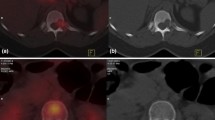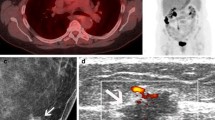Abstract
Imaging diagnostic methods except for mammograms are not recommended for follow-up of postoperative breast cancer patients in order to detect small recurrences because of the poor survival improvement in earlier randomized trials. However, the use of new imaging modalities may improve survival by detection of small isolated regional lymph node recurrences which are potentially curable. Between April 2006 and December 2008, we used PET–CT to find small recurrences in follow-up of 1,907 postoperative breast cancer patients. A total of 3,280 PET–CT imagings were performed. The median age at PET–CT imaging was 58 years, with a median 48-month interval from definitive surgery to the PET–CT imaging. Twenty-two patients were found to have isolated ipsilateral regional recurrences only by PET–CT (axillary node recurrences in 6, infraclavicular node recurrences in 5, supraclavicular node recurrences in 6, and parasternal node recurrences in 5). All of those recurrences were missed by palpation or were nonpalpable. The pathological lymph node status at the definitive surgery for the primary breast cancer of 22 patients with the isolated ipsilateral regional lymph node recurrences was positive in 17 patients. If patients are limited to those who had pathologically positive node(s) at definitive surgery, the incidence of patients with isolated regional lymph node recurrences found only by PET–CT would be 2.6% (17/663 patients). Seventeen other asymptomatic cancers including contralateral breast cancers were found only by PET–CT. Early detection of isolated loco-regional recurrences of breast cancer is suggested to result in improved survival. Therefore, the use of PET–CT in follow-up of postoperative node-positive breast cancer patients may improve their survival because of early detection of isolated regional lymph node recurrences which are still potentially curable, and screening of other asymptomatic cancers.

Similar content being viewed by others
References
Early Breast Cancer Trialists’ Collaborative Group (EBCTCG) (2005) Effects of chemotherapy and hormonal therapy for early breast cancer on recurrence and 15-year survival: an overview of the randomized trials. Lancet 365(9472):1687–1717
Greenberg PA, Hortobagyi GN, Smith TL, Ziegler LD, Frye DK, Buzdar AU (1996) Long-term follow-up of patients with complete remission following combination chemotherapy for metastatic breast cancer. J Clin Oncol 14(8):2197–2205
The GIVIO Investigators (1994) Impact of follow-up testing on survival and health-related quality of life in breast cancer patients. A multicenter randomized controlled trial. JAMA 271(20):1587–1592
Rosselli Del Turco M, Palli D, Cariddi A, Ciatto S, Pacini P, Distante V (1994) Intensive diagnostic follow-up after treatment of primary breast cancer. A randomized trial. National Research Council Project on Breast Cancer follow-up. JAMA 271(20):1593–1597
Khatcheressian JL, Wolff AC, Smith TJ, Grunfeld E, Muss HB, Vogel VG, Halberg F, Somerfield MR, Davidson NE (2006) American Society of Clinical Oncology 2006 update of the breast cancer follow-up and management guidelines in the adjuvant setting. J Clin Oncol 24(31):5091–5097
Veronesi U, Arnone P, Veronesi P, Galimberti V, Luini A, Rotmensz N, Botteri E, Ivaldi GB, Leonardi MC, Viale G, Sagona A, Paganelli G, Panzeri R, Orecchia R (2008) The value of radiotherapy on metastatic internal mammary nodes in breast cancer. Results on a large series. Ann Oncol 19(9):1553–1560
Brito RA, Valero V, Buzdar AU, Booser DJ, Ames F, Strom E, Ross M, Theriault RL, Frye D, Kau S-W, Asmar L, McNeese M, Singletary SE, Hortobagyi GN (2001) Long-term results of combined-modality therapy for locally advanced breast cancer with ipsilateral supraclavicular metastases: the University of Texas M.D. Anderson Cancer Center Experience. J Clin Oncol 19(3):628–633
Olivotto IA, Chua B, Allan SJ, Speers CH, Chia S, Ragaz J (2003) Long-term survival of patients with supraclavicular metastases at diagnosis of breast cancer. J Clin Oncol 21(5):851–854
Recht A, Edge SB, Solin LJ, Robinson DS, Estabrook A, Fine RE, Fleming GF, Formenti S, Hudis C, Kirshner JJ, Krause DA, Kuske RR, Langer AS, Sledge GW Jr, Whelan TJ, Pfister DG (2001) Postmastectomy radiotherapy: clinical practice guidelines of the American society of clinical oncology. J Clin Oncol 19(5):1539–1569
Sobin L, Gospodarowicz M, Wittekind C (2010) Classification of malignant tumours, 7th edn. Wiley-Blackwell, Oxford
Edge SB, Byrd DR, Compton CC, Fritz AG, Greene FL, Trotti A (2010) Cancer staging manual, 7th edn. Springer, New York
Hodgson NC, Gulenchyn KY (2008) Is there a role for positron emission tomography in breast cancer staging? J Clin Oncol 26(5):712–720
Escalona S, Blasco JA, Reza MM, Andradas E, Gomez N (2010) A systematic review of FDG-PET in breast cancer. Med Oncol 27(1):114–129
Isasi CR, Moadel RM, Blaufox MD (2005) A meta-analysis of FDG-PET for the evaluation of breast cancer recurrence and metastases. Breast Cancer Res Treat 90(2):105–112
Piperkova E, Raphael B, Altinyay ME, Castellon I, Libes R, Sandella N, Heiba S, Abdel-Dayem H (2007) Impact of PET/CT in comparison with same day contrast enhanced CT in breast cancer management. Clin Nucl Med 32(6):429–434
Schmidt GP, Baur-Melnyk A, Haug A, Heinemann V, Bauerfeind I, Reiser MF, Schoenberg SO (2008) Comprehensive imaging of tumor recurrence in breast cancer patients using whole-body MRI at 1.5 and 3 T compared to FDG-PET–CT. Eur J Radiol 65(1):47–58
Antoch G, Vogt FM, Freudenberg LS, Nazaradeh F, Goehde SC, Barkhausen J, Dahmen G, Bockisch A, Debatin JF, Ruehm SG (2003) Whole-body dual-modality PET/CT and whole-body MRI for tumor staging in oncology. JAMA 290(24):3199–3206
Lu WL, Jansen L, Post WJ, Bonnema J, Van de Velde JC, De Bock GH (2009) Impact on survival of early detection of isolated breast recurrences after the primary treatment for breast cancer: a meta-analysis. Breast Cancer Res Treat 114(3):403–412
Conflict of interest
None
Author information
Authors and Affiliations
Corresponding author
Rights and permissions
About this article
Cite this article
Ohsumi, S., Inoue, T., Kiyoto, S. et al. Detection of isolated ipsilateral regional lymph node recurrences by F18-fluorodeoxyglucose positron emission tomography–CT in follow-up of postoperative breast cancer patients. Breast Cancer Res Treat 130, 267–272 (2011). https://doi.org/10.1007/s10549-011-1561-8
Received:
Accepted:
Published:
Issue Date:
DOI: https://doi.org/10.1007/s10549-011-1561-8




